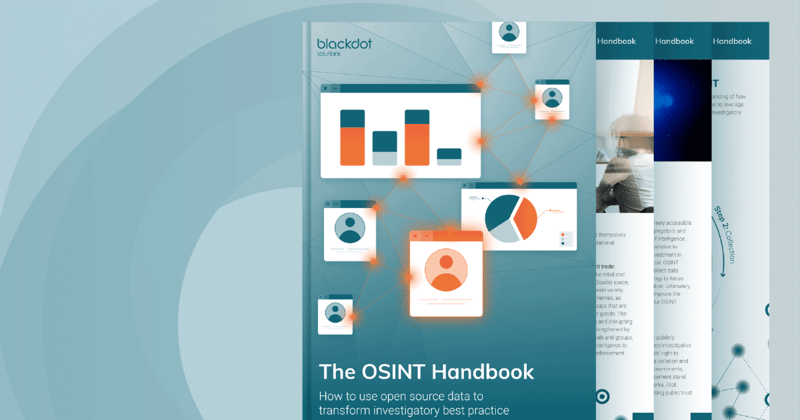For law enforcement and government agencies fighting transnational organised crime, the question is no longer if they should be using Open Source Intelligence (or OSINT) – it’s how. Amidst calls for nations to set up agencies dedicated to the discipline and widely publicised success stories by organisations such as Bellingcat, the pressure is on to ensure that public sector investigators are equipped to conduct OSINT investigations efficiently and thoroughly.
Yet conducting effective OSINT is a challenge. Organisations and investigators using OSINT must grapple with questions around sourcing, accuracy, security and ethics, as well as confronting inevitable data overwhelm.
In this article, we’ll explore best practices for investigators using OSINT to fight transnational organised crime.
Use the broadest range of data sources possible
No investigator wants to miss key information – but in the case of an organised crime investigation, the cost of doing so may be especially high. For this reason, it’s essential that investigators have the ability to make use of any type of data, even if it’s not easy to access.
Such sources could include:
- Foreign-language news
- Corporate records data
- Publicly available social media
- The dark web
In many organised crime cases, combining OSINT with other types of intelligence such as HUMINT is key. Not only does combined intelligence allow investigators to gain additional insights, it can also help to disprove or corroborate theories that would otherwise rely on a single piece of intelligence.
Prioritise highly skilled human investigators
Organisations are under constant pressure to adopt new technologies with promises of time savings and better-quality output. Yet nuanced, highly sensitive transnational organised crime investigations using OSINT are one area where technology should not be considered a blanket solution.
A distinction should be drawn between using technology to augment the experienced investigators carrying out serious and organised crime investigations, and replacing them with entirely automated solutions. Whilst the former option can provide tangible benefits – increasing the efficiency of some manual tasks can leave investigators with more time for analysis – replacing the investigator entirely will result in lost nuance. Even AI cannot replicate the abilities of the human investigator in this context.
Instead, technology should be used to take an investigator to the key data points faster, automate repetitive and time-consuming tasks and reduce the additional noise that is inevitable when dealing with open source data.
Ensure a proportionate, reasoned approach
It goes without saying that fighting transnational organised crime is an essential function of law enforcement: it stops the exploitation of people and the environment, and helps to protect national interests. However, even in this context, ethics should remain a consideration for investigators, or they could risk breaching regulations and doing more harm than good.
To ensure investigation integrity, it’s vital that investigators can demonstrate a reasoned approach to the steps undertaken, and that proportionality is kept in mind throughout. In the context of OSINT investigations, this means avoiding over-collecting data and only keeping what’s needed. It also means prioritising reliability: investigators must challenge their own bias and corroborate findings, especially when reviewing content that may be more opinion than fact on social media or other forums.
Networks to investigate networks
By its very nature, transnational organised crime tends to involve complex networks of people and companies in numerous jurisdictions. Investigators cannot hope to tackle these crimes effectively if they view the people and companies involved in silos. To disrupt organised crime, they must try to see the bigger picture by viewing each element as part of a larger network. In order to do this successfully, investigators need access to global data and in-house foreign language capabilities.
Implementing OSINT for transnational organised crime investigations with technology
How can law enforcement teams implement these best practices on a practical level? The reality is that there is no silver bullet, and a holistic approach and workflow is essential to OSINT success.
That said, implementing each of the best practices discussed above manually is time-consuming and wastes resources that could be put to better use in conducting analysis and preventing crimes. In each case, the answer revolves around combining the right skills and technology.
Focus technology on ‘dull’ manual tasks
As we’ve already discussed, investigators shouldn’t be replaced – instead, they should be given tools that allow them to invest their skills where they are most useful. Using technology to complete more menial, manual tasks is one way of achieving this.
For example, technology can be used to facilitate faster data collection from a wider range of sources. Centralised OSINT platforms like Blackdot Solutions’ Videris bring sources including social media platforms, corporate records data, live internet search engines and the dark web into a single platform so that the investigator does not have to waste time accessing numerous different sites to get the data they need.
Technology can also support investigators to combine internal, privileged and open source data effectively. Solutions like Videris offer data import and open APIs to make combining data types simple. Investigators benefit from the ability to combine, analyse and visualise all relevant data together for maximum insight.
Facilitate analysis without automating decision-making
When it comes to analysis, skilled investigators are well-equipped to make nuanced deductions from the information they’ve collected. However, the correct use of technology can increase efficiency and accuracy.
A useful example is automated cross-matching: rather than leaving investigators to compare hundreds of phone numbers and addresses manually, Videris flags similarities between data so that investigators’ attention is drawn to possible links.
Similarly, investigators may be very capable of reviewing large volumes of data, but technology that allows them to filter and categorise results from multiple sources at once may make it easier to get to relevant information quickly.
Proportionate investigations are effective investigations
The need to ensure that activity remains proportionate and ethical is often perceived as a limiting factor in investigations.
Yet, where OSINT is concerned, the opposite is true: OSINT investigations are at their most effective when data collection is targeted so that insights are not drowned out by noise. Achieving this targeted data handling manually is difficult: investigators must review huge volumes of data to identify the right information.
Here, technology can play a pivotal role in ensuring proportionality and increasing effectiveness. Technology solutions like Videris automatically flag information that may be of interest to the investigator so that less data is brought into the investigation overall, retaining proportionality.
Videris also provides sourcing for all data that is saved, helping investigators prove provenance, even if something is removed from the internet later. Finally, each part of the investigation is logged so that investigators can ensure transparency and consistency across their OSINT processes.
Visualisation tools are non-negotiable
The wide range of technology solutions that are now available for investigators can seem overwhelming, but one type of tool is essential: network visualisation and analysis solutions.
We’ve already discussed the importance of never viewing individuals or companies involved in organised crime in isolation: investigators must be equipped with the tools to ensure that this is achievable. Visualisation tools provide the most effective means of understanding global networks.
Videris offers advanced visualisation tools that automatically map networks across publicly available social media, corporate records and more. Visualisations can be exported at the end of an investigation to provide intuitive, clear reporting to stakeholders.
Law enforcement must prioritise OSINT to fight transnational organised crime effectively
OSINT is already widely in use to fight transnational organised crime, but law enforcement investigations can improve effectiveness by investing in the right technology. Selecting a solution which allows for a balance between automation and investigator input will allow organisations to enhance the intelligence picture while ensuring clear, proportionate and traceable investigations.
If you’d like to discuss these best practices or find out more about how Videris can support your transnational organised crime investigations with OSINT, get in touch.



